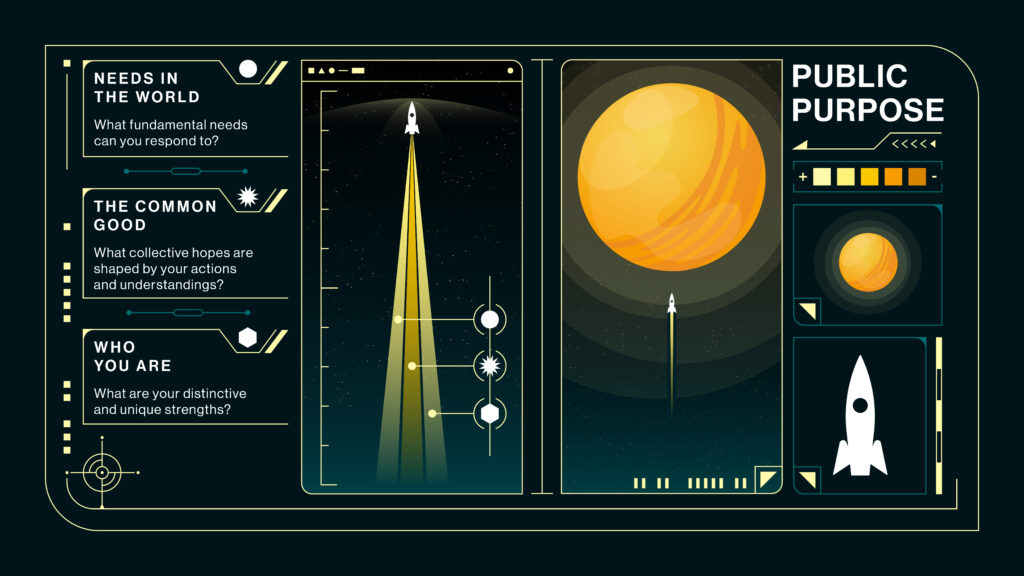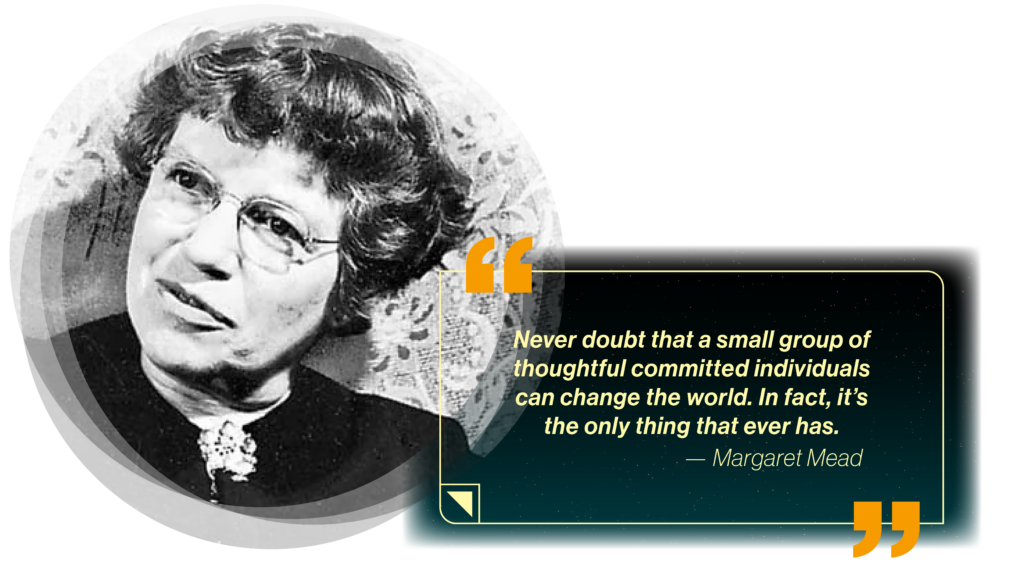What if we never landed on the moon?
Sure, some of the technology we rely on today might not exist. But that’s only a tiny fraction of the story. That perspective looks at what we use, not how we see ourselves. The hearts touched, minds engaged, and imaginations expanded by the moon landing are far more meaningful than any current tech we enjoy. Those who never took part or weren’t even born in the 60s still say “we”, as this human achievement was consequential to countless people. Because of NASA, we’ve seen the distant universe and looked at our own planet from fresh perspectives. This achievement belongs to all, and it only became a reality because of public purpose.

The need for moonshots
We all know the story. In 1962, JFK goes to Rice University and tells everybody, “We choose to go to the Moon in this decade and do the other things, not because they are easy, but because they are hard.” He states this audacious goal to send a man to the moon before the end of the decade. Seven years later, we watch Apollo 11 land on the moon’s surface. Neil steps out onto a foreign celestial body in an unprecedented moment for humanity. That’s what happened. But it’s also an oversimplification of a more complicated story.
Not everyone was on board with the moonshot. Some understandably had more down-to-earth concerns such as civil rights or international conflict. Many openly questioned its usefulness, believing it was not worth our time, treasure, and toil. Cynical naysayers derisively referred to the mission as a “moondoggle.” Yet despite those critics, once the idea had captured the public’s imagination, the drive to see it realized would never quit. Pushing the boundaries of the possible is always a powerful motivator. Even before it was accomplished, the thought “If we can land on the moon, why can’t we do [X impossible thing]” had entered the zeitgeist. Our collective imaginations were set ablaze, and the moonshot wasn’t just an end goal; it was also the start of a new age of innovation.
Today, the word moonshot is often a hyperbolic tag applied to technological breakthroughs in corporate R&D. But moonshots need more than a bold vision and a strategic plan. They need to capture people’s hearts, minds, and ambitions. True moonshots belong to all of us. Their power comes from their ability to ask a lot and promise even more. And they’re important today because we are facing many complicated crises globally where marginal improvements won’t cut it.
To contend with these challenges, tremendous change is needed. Government has an essential role to play in solving these crises, as they operate in the public interest and can deliver goods at scale. By embracing a moonshot philosophy and having a well-defined public purpose, the public sector can drive innovation for the common good.As they have before, moonshots get their muscles from the arms of government.
What makes a good moonshot?
A good moonshot must be both imaginative and ambitious. A possibility that stirs human desires and lies just out of reach. It can’t solely be about a technological achievement. It must also include a human element. People need to feel connected to the outcome, and public purpose is the path to this connection.
Public Purpose
We define purpose as an organization’s north star. It’s timeless and true and can be found where a company’s unique strengths meet a need in the world. With public purpose, we add a third dimension: the common good. By tapping into the collective hopes of humanity and rooting efforts in a shared welfare, we unlock a deep commitment and drive to do something greater than ourselves.

Without identifying and articulating their public purpose, governments limit themselves to a reactive posture when it comes to solving our most pressing issues. Now more than ever, we need our governments to resist the forces pulling them towards the status quo and steady improvements. Change is hard. Meaningfully addressing our issues will require a shift to the bolder thinking the public craves. We need to reimagine the possible, and we can only do that through a deeper understanding of what brings us together – the common good.
Human Connection
We have to speak to people’s hearts – the essence of heroic epics. JFK could’ve merely made an argument for how a mission to the moon would help America. Instead, he narrated the story of a species always pushing to the next frontier. We can use narratives to emotionally connect with people we would otherwise never be able to persuade. In doing so, we turn strangers into allies and build movements. Wouldn’t you rather address a challenge with a team of true believers instead of a group of incentivized employees?

Too often, organizations focus on strategic planning and delivery. Though critical, the story can’t be ignored. Stories are the antidote to small talk and the catalysts of great movements. They’re how we bridge the distance between souls and transcend the millennia between civilizations. They form our lives, shape our species, and bring meaning to existence. Sure, an argument can make a sale, but nothing has the staying power of a good story.
Choose to go because it’s hard
Belonging is a fundamental part of humanity. People need to believe in the cause before they buy into the process. If you try to circumvent or rationalize that away, your team will be concerned about shifting conditions rather than focusing on common goals. Public purpose can mobilize us in a way that profit can only dream of, and it’s precisely what’s needed for a true moonshot. A billionaire’s dream to go into low-earth orbit may capture some headlines but the vision of a future as a multi-planetary species will seize the imagination of generations. That’s the type of work we all want to do. The grandest stage should be reserved for the greater good.
Walking on the moon was not something Neil Armstrong could even think to aspire to as a boy. His parents loved him no less than you love your children, and they raised him on a diet of grounded dreams. They probably saw the moon as something as distant as the heavens, unaware that their son would one day kick up stardust and come back home.
Pause for a second. What are you telling your children? What do you believe is unreachable? What was the last public project you dared to dream, but then quickly dismissed as an impish moondoggle in your mind? Where are you choosing not to go, because it’s just too hard?
We started by asking, “What if we never landed on the moon?” As we close, we think it’s more important to ask, “What if we do something even bigger?”
Generation after generation, humanity proves its ability to do with ease what our ancestors considered impossible. It’s never easy. When it comes to moonshots, what’s easy is finding too many challenges, too few resources, plenty of distractions, and a lot of temptation to delay.
Same story. Different century.
Public purpose lifts your gaze higher, and a powerful narrative connects us to our goals. They show that the common good has uncommon power. We are all on the precipice of some grand, more beautiful reality. Whatever our next moonshot is, together, we can get there.
But first, we have to believe.

Illustrations by BCG BrightHouse Senior Graphic Designer, Sarah Hernandez